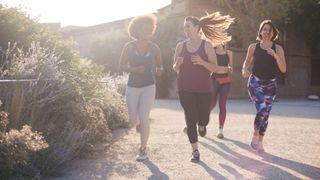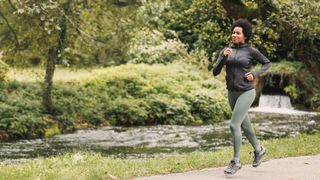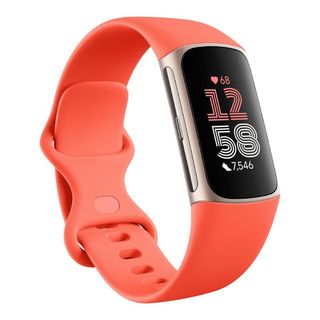What are the benefits of slow running? 7 reasons to try it after 40
There are so many slow running benefits for those looking to try something new, from alleviating menopause symptoms to helping your social life


If you're interested in running but aren't too keen on high-impact work and cardio exercise, why not explore all the slow running benefits instead? As the name suggests, this type of movement is all about going slowly, reducing the impact on the body and focusing more on enjoyment.
Running isn't for everyone and the expectation that you do it in a certain way puts many people off lacing up their pick of the best running shoes and heading out. However, for those who want to give it a go as part of a varied exercise routine and lifestyle, it can be a good option with many benefits of running to be had - from stronger bones and joints to a clearer head.
The foundation of slow running is all about doing what feels good for you. "It's essential to listen to your body during slow runs and adjust your pace as needed," says Lucie Cowan, a personal trainer and running specialist at Third Space. "If you're new to running, a slow pace may be slower than someone who has been running for years. The key is to find a pace that feels comfortable and sustainable for the duration of your run. Over time, as your fitness improves, what you consider "slow" may naturally become faster." So, if you're looking to give it a go, whether you want to know how to start running as a beginner over 50 or want to change up your workout routine, this is what you need to know.
Slow running benefits
1. Slow running can help you reduce stress
Running at a slow, relaxed pace can be mentally soothing and offer a break from the stresses of daily life, says Cowan. The slow running benefits are similar to running meditation in this way.
"It allows you to fully immerse yourself in the meditative aspects of running, fostering mental relaxation," she says. "The calm and rhythmic nature of slow running encourages mindfulness, helping you clear your mind and reduce stress. Many runners find that these easy-paced runs are not just physically rejuvenating but also emotionally and mentally refreshing."
There's even research to back it up. Several studies reviewed by New York University have found that low-intensity exercise (like slow running) is the best workout to stimulate the production of serotonin, aka the 'happy' hormone, and enhance mood. In turn, this can help to reduce stress and even help avoid burnout in some cases.

Lucie is master trainer for classic group exercise at Third Space London. She developed her knowledge and skills in the fitness industry over a number of years alongside working in the science sector and holds three medical science degrees, a Bachelors (BSc), a Masters (MSc) and a Doctorate (PhD). Her role as Master Trainer combines her love for teaching classes, whilst supporting and training other instructors to excel at their passion and inspire their own class members.
2. Slow running can help reduce menopause symptoms
If you enjoy running and are struggling with some of the more uncomfortable symptoms of menopause then slow running may become your new hobby. Exercise can help menopause symptoms by lowering our core temperature, which can help with night sweats, hot flashes, and sleeping difficulties.
Sign up for the woman&home newsletter
Sign up to our free daily email for the latest royal and entertainment news, interesting opinion, expert advice on styling and beauty trends, and no-nonsense guides to the health and wellness questions you want answered.
As noted, the slow running benefits include increasing the production of vital hormones like dopamine and serotonin in the brain. This can help clear the mind, helping with menopause symptoms like brain fog and anxiety.
3. Slow running is another form of strength training
The importance of strength training isn't lost on most of us. Whether it's to combat the symptoms of menopause such as muscle loss or as a useful form of exercise for maintaining our mental health, lifting weights has many benefits.
However, going to the gym or attending a workout class isn't for everyone and running is a weight-bearing exercise as well, with every one of us putting power into the ground with every step.
But that makes it sound more intense than it is - running can help to strengthen the muscles in the legs, torso, and arms, and it's not as intense as some popular strength training exercises as featured in HIIT workout classes, for instance.

4. It can be a new way to socialise
Slow running is generally accepted to be when you can hold a conversation comfortably while on the move, without getting out of breath. This makes it the perfect activity for those who want to start working out with a friend as you need to maintain a speed where it's possible to speak without struggling.
If you're new to running, adding in a social element could help you get started and run for longer sessions too, adding to the list of slow running benefits. A study by the University of Oxford found that those who exercise with others experience a positive effect of more energy and less fatigue, even if they run for the same amount of time as they would on their own.
5. Slow running is good for injury recovery and prevention
There's nothing like a slow run for recovery, says Cowan. Whether you're new to exercise and looking to take a step in slowly or recovering from an injury, it's one of the best places to start.
"Slow running is gentle on your body and provides an opportunity for active recovery," says the trainer. "It puts less stress on your muscles, joints, and tendons compared to high-intensity running. It can also help maintain joint mobility, improve blood circulation, and alleviate muscle soreness, contributing to injury prevention and overall wellbeing."
What is slow running?
Running so comfortably that you can freely speak means you're moving at about 65 to 75% of your maximum heart rate, says Cowan. "The exact pace, measured in minutes per mile or kilometres per hour, will differ for each runner based on factors like their fitness, age, and experience."
That's the brilliant thing about slow running. The definition varies from person to person, so there's even less reason to compare yourself to anyone else. It's just about putting on your trainers and enjoying the run.

Is slow running good for weight loss?
Yes, says Cowan, running slowly can be a valuable part of a healthy weight loss plan, particularly for those new to exercise or looking for a low-impact, sustainable activity. There are two main reasons for this when it comes to losing weight in the 40s and 50s: it's more sustainable and running burns fat better.
"Slow running is often more sustainable for beginners and those returning to exercise as it's gentler on the body and reduces the risk of overuse injuries, making it easier to maintain a consistent running routine," says Cowan. "Running at lower intensities primarily uses fat as a fuel source, which can be advantageous for weight loss, as it targets fat stores for energy, contributing to fat loss over time."
Additionally, running at a slow, steady pace can help you burn calories, which is needed to create a calorie deficit even when dealing with weight gain in menopause.
For the same reasons, indoor cycling and swimming as a workout at a slower pace is a good place to start for those getting back into exercise. Much like anything else, running is only truly beneficial if you enjoy it as you'll keep coming back to it. If you don't enjoy it or find it difficult thanks to painful joints, for instance, try something else. Yoga for beginners and Pilates are both excellent non-cardio options.
"It's essential to combine [running and exercise in general] with a healthy diet and consider the duration and frequency of your runs to ensure you're creating a sufficient calorie deficit for effective weight loss," the trainer adds. "For some individuals, incorporating higher-intensity workouts alongside slow running can provide a more balanced and efficient approach to reaching their weight loss goals."
How long should I run for?
Health organisations like the NHS recommend 150 minutes of moderate exercise every week (or 75 minutes-worth of vigorous-intensity exercise), which should be divided into multiple sessions. That could mean you go running for 20 minutes every day with a bit more at the end, or three times a week for 50 minutes. You could also try a program like Couch to 5k on the treadmill, helping you get in a few 30 minute sessions every week.
Moderate means raising your heart rate, breathing faster, and feeling warmer. Even if you only run slowly, you'll start to experience this as it's more vigorous than a gentle walk and about the same as doing walking as a workout.

Slow running is all about keeping your heart rate low and having an activity tracker can help you do that. The Polar H10 Heart Rate Monitor is an easy, discreet way to monitor your heart rate while on the move. The sensor, which sits on a strap under your sports bra on the breast bone, collects data (which you can then view via the app on your phone) on your heart rate, the heart rate zone you're working in, and how much effort you're putting in.

The Garmin Venu Sq 3 is the latest in the range. It's a smart watch that does everything from tracking your heart rate, heart rate zones, and perceived effort to counting your steps, tracking your runs via GPS, reviewing your sleep quality, and so much more. If you want to start running more often, this watch is an on-wrist essential.

With better GPS and heart rate monitoring than ever before, this is the newest Fitbit on offer. I do find that Garmin heart rate monitoring is a little more pinpoint accurate and the display makes it easier to see what zone you're in, but the Fitbit Charge 6 is another great option for those new to running at a more budget-friendly price point.
Slow running is also a useful tool for those looking to run faster or to run for longer distances, as it helps to build up an aerobic base. As the famous saying goes: run slow to run fast, so if you're planning to run 5km or 10km, for instance, this - as part of an 80/20 running program - could help you make the most of the time you have to exercise.
"When you run at a comfortable, conversational pace, your body primarily relies on oxygen to produce energy. This type of training enhances your cardiovascular fitness, increases the efficiency of your oxygen utilization, and improves your endurance," says Cowan. "Over time, a robust aerobic base allows you to run longer distances without tiring as quickly, making it an essential foundation for all runners, from beginners to advanced athletes."

Grace Walsh is woman&home's Health Channel Editor, working across the areas of fitness, nutrition, sleep, mental health, relationships, and sex. She is also a qualified fitness instructor. In 2024, she will be taking on her second marathon in Rome, cycling from Manchester to London (350km) for charity, and qualifying as a certified personal trainer and nutrition coach.
A digital journalist with over six years experience as a writer and editor for UK publications, Grace has covered (almost) everything in the world of health and wellbeing with bylines in Cosmopolitan, Red, The i Paper, GoodtoKnow, and more.
-
 Amal Clooney has worked it out – here's how to style the daring sheer trend with class and elegance
Amal Clooney has worked it out – here's how to style the daring sheer trend with class and eleganceAmal's sheer red dress delivered an elegant and sophisticated take on the sultry trend
By Charlie Elizabeth Culverhouse Published
-
 Our experts explain why all five of us love the Magimix Powerblend 4 for a family home
Our experts explain why all five of us love the Magimix Powerblend 4 for a family homeThe Magimix Power Blender 4 is the best quality blender on the market: it can handle hot and cold foods, boasts immense power - it is a firm woman&home favourite
By Laura Honey Published